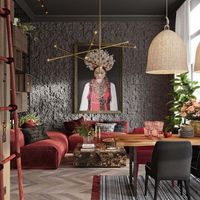## A Modern Bag 3D Model: A Fusion of Style, Functionality, and Technological Prowess
3D modeling has revolutionized the design and production process, offering unparalleled flexibility and visual clarity. This has been particularly impactful in the world of fashion and accessories, where realistic 3D models have become indispensable tools for showcasing designs, exploring variations, and facilitating efficient production.
One such example of the power of 3D modeling is a modern bag 3D model. This digitally crafted representation transcends the limitations of traditional design methods, allowing for the creation of innovative and intricate designs that are not only visually stunning but also highly functional.
### Part 1: Unveiling the Potential: Why a Modern Bag 3D Model Matters
Imagine being able to visualize a bag in its entirety before it even exists in the real world. With a modern bag 3D model, this becomes a reality. This model provides a comprehensive and interactive platform for:
1. Design Exploration and Innovation:
* Unleashing Creativity: Designers can experiment with various shapes, materials, textures, and colors with ease, pushing the boundaries of conventional bag designs. The 3D model acts as a virtual playground, allowing them to visualize and refine ideas before investing in physical prototypes.
* Optimizing Functionality: 3D modeling enables the precise placement of pockets, compartments, and closures, ensuring that the bag is not just visually appealing but also practical and user-friendly.
2. Client Visualization and Communication:
* Clear and Immersive Presentation: The modern bag 3D model allows designers to create high-quality renders and animations, offering clients a clear and realistic understanding of the final product.
* Reduced Communication Gaps: This immersive experience eliminates ambiguity and misunderstandings between designers and clients, leading to a smoother and more efficient design process.
3. Production Efficiency and Cost Reduction:
* Virtual Prototyping: Creating multiple 3D models allows designers to test different variations and identify potential flaws in the design before committing to production. This saves time and resources, leading to a more cost-effective production process.
* Precise Measurements and Specifications: The 3D model provides accurate dimensions and measurements, ensuring that the final product meets exact specifications. This eliminates the need for costly and time-consuming adjustments during production.
### Part 2: Building the Model: Exploring the Technical Aspects
The creation of a modern bag 3D model involves a sophisticated interplay of software, skills, and artistic vision. Here’s a deeper look into the technical aspects of this process:
1. Software and Tools:
* 3D Modeling Software: Programs like Blender, Maya, 3ds Max, and ZBrush are commonly used to create 3D models. These tools allow designers to manipulate vertices, faces, and other geometric elements to build the bag's form.
* Texturing and Material Mapping: Software such as Substance Painter, Quixel Mixer, and Marmoset Toolbag help designers create realistic textures, apply materials, and simulate different fabrics and finishes.
* Rendering and Animation: Software like V-Ray, Corona Renderer, and Octane Render are used to create photorealistic images and animations of the 3D model.
2. The Design Process:
* Concept Development: The process starts with a clear vision of the bag's intended style, target audience, and functionality. Designers often create sketches or mood boards to guide their approach.
* Model Creation: The 3D model is built using a variety of techniques, including polygon modeling, NURBS modeling, and sculpting. Each technique offers its unique benefits for creating specific features and details.
* Texturing and Material Application: Once the basic form is complete, designers apply textures and materials to create visual realism. This step involves selecting appropriate colors, patterns, and fabrics to match the design vision.
* Lighting and Rendering: The final step involves setting up lighting to enhance the model's visual appeal and rendering the model to create high-quality images or animations.
3. The Importance of Detail:
* Precision in Detail: Modern bag 3D models are characterized by their high level of detail, from the intricate stitching and zippers to the subtle folds and creases of the fabric. This realism is crucial for accurate representation and effective communication.
* Leveraging Technology: Advanced 3D modeling software allows designers to create highly detailed models with ease, enhancing the overall visual impact and credibility of the final product.
### Part 3: The Impact of 3D Modeling on the Future of Bags
The adoption of modern bag 3D models has far-reaching implications for the future of the bag industry:
1. Increased Design Innovation:
* Breaking Barriers: 3D modeling eliminates the constraints of traditional methods, allowing designers to explore unconventional shapes and constructions that were previously impossible to create.
* Embracing Sustainability: The virtual prototyping enabled by 3D modeling reduces the need for physical prototypes, minimizing material waste and promoting sustainable design practices.
2. Personalized Experiences:
* Customizable Designs: The flexibility of 3D modeling allows for the creation of bespoke bags, tailored to individual preferences and needs. Customers can choose from a wide range of customization options, from colors and textures to functional features, creating a truly unique and personalized experience.
* Virtual Try-on: 3D models can be integrated into virtual try-on platforms, allowing customers to visualize how a bag will look on them before purchasing, enhancing the shopping experience and reducing returns.
3. Enhanced Production Processes:
* Automated Manufacturing: 3D models can be used to drive automated production lines, optimizing efficiency and reducing the need for manual labor. This allows for mass customization and flexible production schedules.
* Improved Collaboration: Cloud-based platforms facilitate seamless sharing and collaboration between designers, manufacturers, and clients, streamlining the entire design and production process.
Conclusion:
The modern bag 3D model represents a paradigm shift in the way bags are designed, visualized, and produced. Its ability to merge creativity, functionality, and technological advancement makes it a powerful tool for designers, manufacturers, and customers alike. As technology continues to evolve, we can expect even more innovative and impactful applications of 3D modeling in the world of bags and fashion, pushing the boundaries of what is possible and shaping the future of the industry.


















Comment (0)